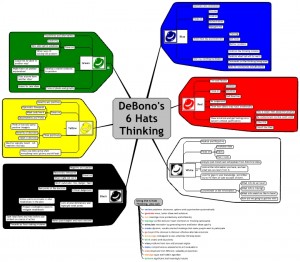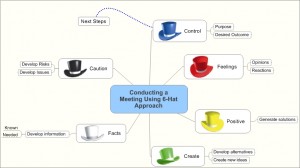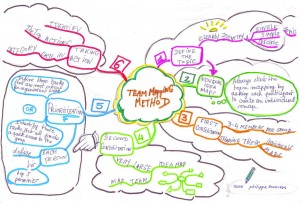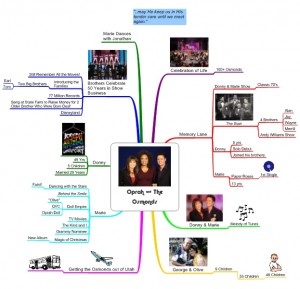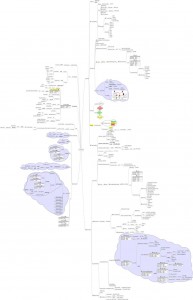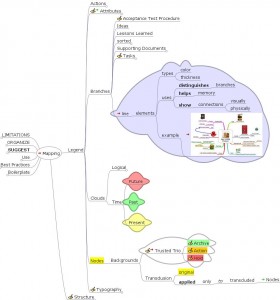An Idea Mapping Success Blogs Weblog
Secrets of the Millionaire Mind – Idea Map #97
26 Mar 2008 Author: Jamie Nast In: Book Reviews, Books, Idea Mapping Example, Mind Mapping Examples Secrets of the Millionaire Mind is a book written by T. Harv Aker. This idea map was created by Debbie Edwards Miller after she attended the 2-day workshop “Idea Mapping: A Learning Workshop” that was held at ACH (Automotive Components Holding, LLC). It summarizes the content of the book. The photo I took of her map is a little dark. The pdf version is available on my website. Go to Client Maps and then scroll down to “Secrets of the Millionaire Mind”. The maps are listed in alphabetical order. Although a few of the edges are cropped, it is clearer to read. Thanks Debbie!
Secrets of the Millionaire Mind is a book written by T. Harv Aker. This idea map was created by Debbie Edwards Miller after she attended the 2-day workshop “Idea Mapping: A Learning Workshop” that was held at ACH (Automotive Components Holding, LLC). It summarizes the content of the book. The photo I took of her map is a little dark. The pdf version is available on my website. Go to Client Maps and then scroll down to “Secrets of the Millionaire Mind”. The maps are listed in alphabetical order. Although a few of the edges are cropped, it is clearer to read. Thanks Debbie!
Chuck Frey’s New Mind Mapping Manifesto
24 Mar 2008 Author: Jamie Nast In: Mind Mapping Software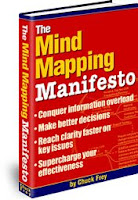 Chuck Frey (the author of the Mind Mapping Software Blog) has just released a new e-book.
Chuck Frey (the author of the Mind Mapping Software Blog) has just released a new e-book.
The Mind Mapping Manifesto contains:
- The true cost of information overload and multi-tasking
- Proven research on the business benefits of mind mapping software
- Perspectives from 10 mind mappers on how software has impacted the way they think, plan and work
- 20+ business applications where mind mapping software can be used to increase efficiency
- Ten tips on selecting the right program for your needs
- A checklist to help you identify your needs
- Reviews of Chuck’s 5 top mind mapping programs
- Chuck’s “best of” list of the programs that offer the greatest performance in 8 key areas.
- A collection of over 50 resources where you can discover the best tools, resources and advice about mind mapping software
Order The Mind Mapping Manifesto today for just $19.95 USD!
de Bono’s 6 Thinking Hats – Idea Map #96
19 Mar 2008 Author: Jamie Nast In: Idea Mapping Example, Idea Maps for Meetings, Mind Mapping ExamplesOne of my clients from a large automotive company in southeastern Michigan gave me these idea maps she created around de Bono’s Six Thinking Hats.
The top map is a description of the Six Thinking Hats and what each hat represents in terms of its focus as well as the benefits to using this method. The second map was used to run a meeting. This map was used to analyze a plan and focus the team on one hat at a time — for example, Black Hat – “let’s all think of the negatives with this plan”, Yellow Hat – “let’s all think of the positives associated with this plan”.
For a larger view of this map see the pdf versions by clicking here then scrolling alphabetically to the map titles “DeBono’s Six Thinking Hats” and “Using DeBono’s Six Thinking Hats for a Meeting Agenda.”
Announcement: Two new Idea Mapping Workshops have been added to Jamie’s 2008 schedule. See the Course Schedule for upcoming Vancouver, B.C. and UK classses. More info to come in later postings.
Team Idea Mapping Method – Idea Map #95
18 Mar 2008 Author: Jamie Nast In: Book Reviews, Group Idea Maps, Idea Mapping Example, Mind Mapping ExamplesIn my previous posting Philippe Boukobza shared an idea map summarizing the contents of my Idea Mapping book. Today’s map is also from Philippe and details chapter 9 of my book which covers the “Team Idea Mapping Method”. I have used this process successfully with many clients. It helps to gather a multitude of ideas from every participant, keeps a dominant person from taking over the direction of the meeting, fosters shared understanding, give the group a “picture” of their ideas, is more effective than standard brain storming, and no idea gets left behind.
Idea Mapping Book Summary – Idea Map #94
14 Mar 2008 Author: Jamie Nast In: idea mapping book, Idea Mapping Example, Mind Mapping Examples
Philippe Boukobza from Spain previously contributed his book summary of Flow by Mihaly Csikszentmihalyi. His blogs are in English, French, and Spanish. His contribution today is a map he created of my book, Idea Mapping! This idea map was created using Inspiration 8. Thanks Philippe.
Oprah & The Osmonds – Idea Map #93
12 Mar 2008 Author: Jamie Nast In: Certified Idea Mapping Instructors, Debbie Showler, Idea Mapping Example, Mind Mapping ExamplesDebbie Showler’s idea map from the Oprah Show (posted on this blog on February 15, 2008) has been so popular that I decided to include another map of Oprah’s Show. If it continues to be a popular hit, maybe I will consider a once-a-month Oprah Idea Map!
I created this summary map from yesterday’s history-making TV show titled, “Oprah & The Osmonds”. Gathered together were over 100 Osmonds in a tribute to their parents.
For a larger view of this map in pdf format go to my website under “Additional Maps”. If you click on any column it will sort alphabetically by author or title of the map.
2008 USA Memory Championship Results
11 Mar 2008 Author: Jamie Nast In: MemoryWhat is the Benefit of Colored Branches? Idea Map #92 and Hint #20
10 Mar 2008 Author: Jamie Nast In: Helpful Hints, Idea Mapping Example, Mind Mapping ExamplesOn Wednesday, March 5, 2008 I introduced you to Jay Dugger — long-time mind mapper. The purpose of this posting is two-fold. First, the full version jpg of Jay’s map titled “Mapping” is now available above and in pdf format at my website under “Additional Maps”. If you click on any column it will sort alphabetically by author or title of the map. Secondly, I promised to address the issue of line color. That will be today’s Hint #20.
Keep in mind these are not rules that need to be followed, just helpful hints that can be applied depending on your purpose.
- The branches surrounding the central image are sometimes thicker to show that they are a main thought.
- Let’s say you have one branch that is red along with all sub branches that attach to it in any way. The ideas are now connected in two ways — both physically and visually.
- If each main branch (and associated sub branches) is a different it makes the branches stand out from each other.
These three hints all blend together for one purpose — improved memory and interest. Take a look at any map that uses all black branches and words. They are rather boring, but again it’s the purpose of the map that will drive these decisions.
This map and many others can be viewed in the Idea Mapping Flickr Photo Stream.
Today’s USA Memory Championship
8 Mar 2008 Author: Jamie Nast In: Memory(On Wednesday I promised that this posting would be a follow-up to the discussion about line color. I’m bumping that to Monday’s blog and I even have Jay’s full map to share with you instead of the shrunk version.)
Today in New York City, Con Edison is hosting the 11th USA Memory Championship in Manhattan. My friend Tony Dottino (Founder of this event) told me yesterday that they have 6 high schools competing this year in addition to the individual competitors. Scott Hagwood (4-time USA Champion, 1st USA Grand Master of Memory and author of Memory Power) is going to be my eyes and ears this weekend, and he’ll report back any news next week. The Championship Round will be broadcast on April 22nd at 10pm EST on HDNet TV.
See a course abstract for my 1-day Memory Power Workshop and the Memory & Speed Reading Workshop.
A Map Titled “Mapping” – Idea Map #91
5 Mar 2008 Author: Jamie Nast In: Helpful Hints, Idea Mapping Example, Mind Mapping ExamplesA while back Jay Dugger was asking about the significance of the various line colors in some of the maps on this blog. I’ll address the theory and benefits to this in the next posting. Meantime, Jay has contributed an idea map he calls, “Mapping.” I’ll let Jay explain this map (created using FreeMind) in his own words:
“I use “Mapping” to collect my ideas about mind mapping techniques. I use mind maps to manage projects, tasks, and actions. This works well, but I was spending a great deal of time replicating similar and recurring events and tasks. So I wrote a boilerplate to give my map a recurring visual structure for the branches that described similar events and tasks. “Mapping” began as a map that stored boilerplate branches. I accumulated other conventions (symbols, colors, clouds, typography) in my maps over time. I recorded what they signified on “Mapping.” Eventually I compared my mind map use with that of other people. When I wanted to adopt or test a method or an idea, I recorded it in “Mapping. The use of line thickness and color from “It’s Not About the Coffee” (the February 9, 2008 posting in this blog) “Mapping” so I have a place to remind myself to test using line color and thickness, and so I have a place to record its results. I will probably try replacing the colored clouds I use to show past, present, and future with line colors. I expect this will reduce a map’s visual clutter by using fewer pixels to signify the same ideas.”
The above map has the other branches “shrunk”. Jay’s original map can be found on Flickr, and current versions on Mappio and FreeMindShare. If I can get a pdf of the entire map from Jay, I’ll put it on my website so that you can see the entire map.
Idea Mapping Blog
The purpose of this blog is to share idea mapping examples and related learning from my Idea Mapping, Memory, Speed Reading, and Certification Workshops. This blog is dedicated to my Certified Idea Mapping Instructors, my clients, Mind Mapping and Idea Mapping practitioners around the globe.
![[Ask]](http://ideamapping.ideamappingsuccess.com/IdeaMappingBlogs/wp-content/plugins/bookmarkify/ask.png)
![[del.icio.us]](http://ideamapping.ideamappingsuccess.com/IdeaMappingBlogs/wp-content/plugins/bookmarkify/delicious.png)
![[Digg]](http://ideamapping.ideamappingsuccess.com/IdeaMappingBlogs/wp-content/plugins/bookmarkify/digg.png)
![[Facebook]](http://ideamapping.ideamappingsuccess.com/IdeaMappingBlogs/wp-content/plugins/bookmarkify/facebook.png)
![[Google]](http://ideamapping.ideamappingsuccess.com/IdeaMappingBlogs/wp-content/plugins/bookmarkify/google.png)
![[MySpace]](http://ideamapping.ideamappingsuccess.com/IdeaMappingBlogs/wp-content/plugins/bookmarkify/myspace.png)
![[Slashdot]](http://ideamapping.ideamappingsuccess.com/IdeaMappingBlogs/wp-content/plugins/bookmarkify/slashdot.png)
![[Sphinn]](http://ideamapping.ideamappingsuccess.com/IdeaMappingBlogs/wp-content/plugins/bookmarkify/sphinn.png)
![[StumbleUpon]](http://ideamapping.ideamappingsuccess.com/IdeaMappingBlogs/wp-content/plugins/bookmarkify/stumbleupon.png)
![[Technorati]](http://ideamapping.ideamappingsuccess.com/IdeaMappingBlogs/wp-content/plugins/bookmarkify/technorati.png)
![[ThisNext]](http://ideamapping.ideamappingsuccess.com/IdeaMappingBlogs/wp-content/plugins/bookmarkify/thisnext.png)
![[Twitter]](http://ideamapping.ideamappingsuccess.com/IdeaMappingBlogs/wp-content/plugins/bookmarkify/twitter.png)
![[Webride]](http://ideamapping.ideamappingsuccess.com/IdeaMappingBlogs/wp-content/plugins/bookmarkify/webride.png)
![[Email]](http://ideamapping.ideamappingsuccess.com/IdeaMappingBlogs/wp-content/plugins/bookmarkify/email.png)
